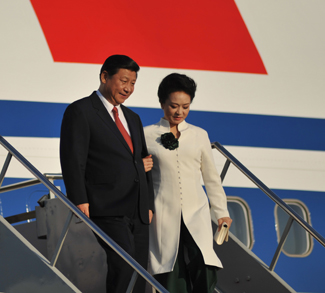In spite of the abundance of opinions voiced almost daily by foreign policy experts and international relations academics there is no consensus about China’s strategic and tactical motivations regarding the South China Sea (SCS). But if one considers China’s history, as well as its geography, resources, and economy clues emerge which give us some perspective about why China is so categorical in its resolve about the South China Sea.
Beijing claims roughly 90% of this sea, which lies in the Pacific Ocean, encompasses an area of around 3.5 million square kilometers (1.4 million square miles), and is shared by Brunei, Cambodia, China, Indonesia, Malaysia, the Philippines, Singapore, Taiwan, Thailand, and Vietnam.
Several of these states, some of which are United States allies, are engaged in territorial and maritime disputes over a number of islands, reefs, and waterways.
Some like the Philippines have accused China of bullying and intimidation to force its sovereignty over the areas it claims as part of its mainland. They claim that China has constructed a number of artificial islands in the SCS and that its warships routinely patrol and harass the navies of other Southeast Asian countries.
The tension noticeably grew in 2023, prompting the 11-member Association of Southeast Asian Nations (ASEAN) to express concern that the disputes could “undermine peace, security, and stability in the region.” China is not a member of ASEAN but is the bloc’s largest trading partner.
The United States has weighed in on the South China Seas by supporting its allies in the region; in March of this year, it condemned Chinese naval action in the dispute with the Philippines: “The PRC’s actions are destabilizing to the region and show clear disregard for international law,” a US State Department statement said. The statement went on to reaffirm the 1951 US-Philippines Mutual Defense treaty.
Washington’s read of the South China Sea, and its involvement in what China says is a regional issue, is further raising the mercury on tensions with Beijing.
US and Western strategists tend to focus on 3 concerns:
- The maintenance of a rules-based order which requires
- preoccupation on the safety of allies which necessitates
- freedom of navigation in the seas.
Western journalists and scholars writing about the disputes inculcate these issues as the crux of the matter. The result is that presumptive motivations are projected onto Chinese behavior and actions are interpreted based on these assumptions.
Western analysis of Chinese actions in the South China Sea emphasizes to its detriment three aims which it views as Chinese priorities:
- Securing China’s strategic lines of communication;
- Precluding or defeating decisively any seaborne attack by foreigners;
- Building sufficient strategic nuclear deterrence.
But if one examines the statements China has voiced (sometimes repeatedly) or its published documents–including correspondence between officials – a defining question emerges:
Why is China willing to risk conflict to protect its interests in the South China Sea?
A cogent response comes into specific relief as we consider China’s disclosures. Moreover, most of these documents are not subject to classified intelligence proscriptions.
Yet, the view from China – from the official documents available – reveals an assessment contrary to that of the West.
In May 2015 China issued a White Paper on Military Strategy in which 3 major concerns for China were delineated: hegemony issues, power politics, and neo-interventionist policies.
The document further discloses that top priorities for the military were to “safeguard [China’s] national unification, territorial integrity, and development interests.”
It is evident that the United States and China look at the same problem and emerge with distinctly different assessments. The central issue for the U.S. is transit through the South China Sea as part of the “international resource domains.” Chinese resolve amounts to defending the South China Sea as integral to its sovereign territory. US experts on the region must begin to treat this differing view from China with the import it deserves if they are to understand what is truly motivating the disputes there.
One thing is certain though, the Chinese leadership is focused on those difficulties and seems intent on resolving them in what can only be viewed as China’s best interest. In June 2014 Chinese President Xi Jinping asserted that China must place the “highest priority on building an impregnable wall for border and ocean defense.” Xi has repeatedly focused on “the need to firmly uphold China’s territorial sovereignty, maritime rights and interests, and national unity, and properly handle territorial and island disputes.”
The Western assessment of Chinese priorities could be a misreading of the situation. The priority of issues is significant in that the following three tasks deal with the return of territory and resources under Chinese sovereign control: 1) reunifying Taiwan with the mainland; 2) the return of lost and disputed maritime territory; and 3) defending national maritime resources.
If one considers the comments previously noted by Xi since 2014, this hierarchy of goals indicates Chinese leadership’s obsession with ending the country’s “national humiliation” historically at the hands of the Western powers. The “Century of Humiliation” (1839-1949), refers to a period when China was dominated and occupied by colonial powers. Failure to understand the importance of this hierarchy of aims is to misunderstand the key motivations driving Chinese policy and the contentious issues in the South China Sea.
China behaves the way it does in the South China Sea based upon nationalist readings of regional history. Thus, China’s behavior is driven by the idea of sovereign entitlement to the islands and other natural structures in the waters of the SCS.
This sense of entitlement is robust. Moreover, it will likely lead China over the coming years to be even more assertive in the region. Continued encroachment into strategic and resource-rich areas along with possible confrontations are quite real.
Given the geography and increasing US and British political and military hegemony in the area, strategic considerations are important to China. China is a country dependent on trade; thus, access to the open ocean through the South China Sea is a matter of national survival. From China’s perspective there is a real possibility that at some point, US military war strategy would attempt to limit or impede maritime trade accessibility–to cut China off from what it needs to continue as a functioning, viable nation–economically and politically.
A few statistics illustrate why China acts the way it does with regard to that large body of water on its south eastern coast. In 2013 China surpassed the U.S. to become the world’s largest net oil importer; it had already been a net importer of food since 2008. Moreover, foreign trade constitutes about 37% of China’s GDP. Yet, the country has no clear access to the open sea. The South China Sea is its lifeline to the oceans of the world and its ability to survive should the worst happen.
China’s defensive policy is designed to develop strategies against US efforts to support Taiwan in the event of a conflict. China’s new island bases greatly improve its early warning systems. Furthermore, it would be much easier for China to construct a base for its new Jin-class ballistic missile submarines if it were able to control the deep-water areas like the Scarborough Shoal.
It should be noted further that there are many Chinese officials (i.e. bureaucrats) who support a more assertive policy. This illustrates interest among industry groups, including the fishing industry and state-owned energy companies, which stand to benefit from an assertive South China Sea policy. The power of these interest groups is immense when they work together to benefit China. One thing is certain, everyone in China (industry, military, civilian, government) agrees that whether for reasons of nationalism, security, profit or jobs, China must gain access to and resources from the South China Sea.
Historic Rights
Underpinning these defensive and bureaucratic motivations is a particular, nationalistic version of history.
The official Chinese view is that only Chinese ships ever used the South China Sea, therefore, China has historic rights to waters inside its “nine-dash line” claim. In July 2016, an International Arbitral Tribunal
in The Hague ruled there were no legitimate grounds for China to claim historic rights. Nonetheless, the argument of claims based on historic rights continues to be the predicate for the ongoing conflict between China and neighboring Southeast Asian states.
The United States, as noted previously, has tended to discount the territorial elements and focus only on issues regarding their view of China’s “comprehensive strategy.” Not only is this once more a misreading of Chinese strategy, it is a miscalculation which could be a harbinger of future conflict. Should the issue of entitlement not be taken seriously, it could predispose to conflict. And the latter cannot be resolved by any “display of Western military prowess.” The fundamental cause of China’s sense of historically-based entitlement needs to be understood as a reality for China–it won’t go away by itself.
China’s view is that it is essentially correcting mistreatments and wrongs that were historically perpetrated against it. A concern is that the other countries in the dispute do not appreciate the importance of this view held by China–for China it is a matter of principle. Moreover, from Beijing’s vantage point – they are essentially reclaiming “lost” territory.
China Remembers
Any behavior by a foreign power to obstruct the reunification of what is considered sovereign territory will be countered – including a verdict by an international arbitral tribunal. It is simply another chapter in a protracted story of foreign efforts to carve up Chinese territory–to take something from China. If policymakers in the US ignore the motivating power of China’s historical narrative, territorial imperative and sense of humiliation driving it, then Western leadership understands neither China’s objectives nor the Chinese mind.
Neither diplomacy (talk) nor confrontation (action) will diminish the motivation behind China’s actions in the South China Sea. Western military encroachment may impede Chinese movements in the short term, but it will also manifest great frustration and provoke calls for an even more assertive response. What will remain, unreservedly, is China’s commitment to and strong presence in the South China Sea – the defense of its coast, sea lanes, and nuclear deterrent. China’s strategic reasons for maintaining a strong presence in the SCS are not negotiable–they are predicated upon existential needs, driven by prior humiliation.
The status quo, however, is also deleterious to China’s interests. The recent encirclement of much smaller Philippine vessels and injuring of Filipino servicemen at the hands of Chinese maritime forces will reinforce international concerns over China’s rise as a major power. And China’s newly imposed regulations against “trespassing” foreigners across its claimed territories in the South China Sea only raise the risk of accidental clashes and casualties.
In an article for the South China Morning Post, Professor Richard Heydarian, Chairholder in Geopolitics at the Polytechnic University of the Philippines, asserts: “As an aspiring leader in Asia, China can ill afford to be seen as a bully and, worse, risk an armed confrontation with the Philippines and potentially the United States, which has reiterated its commitment to help in an event of a contingency in the South China Sea.”
It is therefore incumbent on China, as the more powerful party, to re-examine its approach to the Philippines in favor of de-escalation and mutually beneficial agreements. On its part, the Marcos administration should ensure that it maintains robust communication channels with China, avoids getting dragged into a US-led “Asian NATO,” and engages with the rest of ASEAN to pursue an inclusive and stable regional order.
Yet, tensions in the region are also being fed and will continue to be exacerbated by the activities of the U.S. and its allies. Western naval vessels are routinely sent on so-called “freedom of navigation” missions through the area claimed by Beijing as its exclusive economic zone.
If there is ever to be mutually beneficial agreements (and some degree of trust) between the states proximate to the South China Sea, foreign powers must be distanced from any negotiations at an international forum to hear grievances, disputes, and “global commons” access to the South China Sea.
China will not allow her access to the commercial sea lanes be restricted – to do otherwise would be an existential threat to her
A Way Out
There remains a course of action to pursue, other than potential conflict, if the states in the region can distance themselves from the economic and political influence of the West. All states with an interest in a peaceful solution to the South China Sea disputes need to take China’s view of history seriously. In doing so, the following suggested actions by the interested parties should be considered at least as a preliminary course to avoid conflict:
First, there must be removed from the discourse regarding the South China Sea those states that have no valid territorial claim in or relating to the SCS (United States, UK, EU, etc.).
Second, all claimants to islands, reefs and waters within the South China Sea must have a specified period of time in which to determine their claims and file them with the appropriate international concern.
Third, a South China Sea summit-level organization should be convened to settle discrepancies in the claims, but essentially to develop a strategy whereby each country is accorded the right to participate in the development of natural resources of the SCS.
Fourth, the claimants to territory within the confines of the South China Sea must enter into an agreement (i.e. treaty) whereby each agrees to withdraw all military material (including personnel) from disputed territories.
Fifth, the signatories agree not to utilize any territorial possession for military purposes or deploy any material that could be used for military purposes.
Having suggested the above, there will be substantial pushback from the West regarding this approach to conflict resolution. Their economic and political interests are not advantaged by resolving the South China Sea dispute unless it is accomplished on terms favorable to the West, economically and politically. As long as there is tension in the region these external power brokers will foster a position that makes peaceful resolution to disputes cumbersome at best. Time and economics are on their side.
The views expressed in this article belong to the author(s) alone and do not necessarily reflect those of Geopoliticalmonitor.com.




